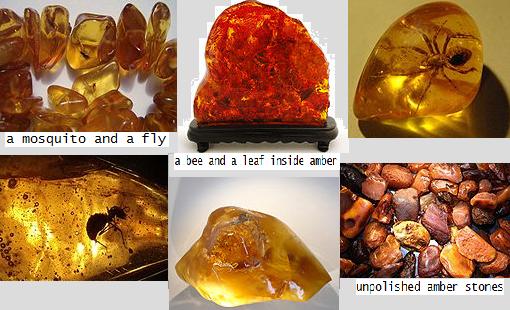Amber 
Mohs scale hardness: 2-2.5
Amber is not a stone, it is an organic material made from fossil tree resin, not a typical gemstone mineral. Organic refers to having its origin in living things. These resin dripped from and oozed down the trees of ancient forest. Amber is an amorphous mixture of organic compounds, including hydrocarbons, succinic acid, resins and oils. Amorphous means that it has no crystalline structure. It is a hard brown-yellowish substance used to make jewelry and other ornamental articles.
Amber Characteristics
However, it is not a fossil in the common sense. Fossils mostly begin by having a plant or animal buried in the earth. The organic material is replaced slowly with elements from the mineral kingdom over a period of millennia. On the other hand, amber has not had its organic elements replaced. Instaed, the resin has gone through a chemical transformation. It has become a polymer, a natural plastic.
People often classify amber as a gemstone due to its colour and beauty. Amber is not made from tree sap (a vital circulating fluid of a plant) as many people always thought. Sap is the fluid that circulates through a vascular system of a plant, while resin is the semi-solid amorphous organic substance that is secreted in canals and pockets through epithelial cells of the plant. The resin may be produced by the tree to protect it from disease and injury inflicted by fungi and insects. Resins possess odors or tastes that both repel and attract insects. Resin may be exuded from the tree to heal a wound such as a broken branch. In mature trees, this resin may simply exude from vertical fissures in the bark ddue to tension produced by rapid growth. The resin may also be produced as a method for disposing of excess acetate.
Because amber degrades and oxidizes when exposed to oxygen, it is preserved only under certain conditions. Therefore they are almost always found in dense, wet sediments, such as sand and clay that formed at the botom of an ancient lagoon or a river delta.
Amber is light in weight (but heavier than water), warm to the touch and the color is not always yellowish-brown, it can be found in blue, brown, whitish color, lemon color, orange, red (cherry amber), green, and even black. Many of the most valuable amber is transparent.
Insects in Amber
Amber can contain many preserved animals inside such as gnats, wasps, flies, ants, bacteria, amoebae, bees, centipedes, spiders, frogs, scorpions, and lizards or preserved plants such as flowers, seeds, mushroom caps, stems, pine cones and pine needles that are tens or hundreds of millions years old. Sometimes fur or feathers can be found inside too. Because these fossils are not the same species taht are alive today, these frequent fossil inclusions that are often seen in amber normally add to the stone’s unique look and can greatly increase its value. More than 1,000 extinct species of insect have been identified in amber.
How to Identify Amber
Amber is often confused with copal which is also a tree resin but has not fully fossilized to amber. They are nearly identical in origins. The difference between those two is that amber is millions of years old, while copal just a few hundred thousand years old.
When heated amber will turns soft and starts to yield fragrant odour and when it is overheated it can be burnt out completely. If it is rubbed with a cloth, it will atract ashes, dust and small pieces of paper. These techniques will not distinguish amber from copal, but the techniques will separate amber from plastic imitations. To distinguish between copal and amber is not that simple since they share the same specific gravity, refractive index and most other properties. There is strong debate about certain deposits of African amber as to whether it is true amber or copal.
There are several treatments that can be carried out on amber gemstone like heating, dyeing, surface coating and amber reconstruction. Heating is applied to increase the inclusions and enhance the color, dyeing is done to give it an aged look, surface coating is done to remove any damages or blemishes on the surface. Reconstructed ambers are made by pressing small pieces of amber together with linseed oil at high temperature and pressure. Reconstructed amber is also called ambroid. This can be distinguished with a microscope. Many ambers used in commercial jewelry is actually reconstituted which makes them harder and less prone to scratching. Reconstituted ambers and processed ambers usually do not have natural inclusions.
Probably amber is consider the oldest substance that is used for human adornment. Pendants and beads made from this substances were found in northern European gravesites in 8000 B.C. Most of the ambers that are found today are 30 to 90 million years old. The largest and richest amber deposits can be found in the Baltic Sea region. Baltic amber is older and more valuable while amber from the Dominican Republic is likely to have more insect inclusions, which are prized by collectors. The Dominican amber is said to be softest and the Burmese amber is the hardest. The percentage of succinic acid contained in the amber determines its quality. The highest percentage of succinic acid found in the ambers are from the Baltic Sea region. Be ware of glass, plastic, synthetic resin and other natural resins amber imitations.
It is believed amber have special properties:
• To improve eyesight by gazing into it.
• In ancient times this aromatic resin was used to cleanse the air by burning it, especially during childbirth.
Amber is not a birthstone, but astrologically, amber is associated with the zodiac signs of Taurus.
Copyright © 2009 Game Frog
Home | Contact | Disclaimer | Privacy Policy